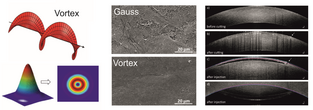Refractive surgery
The human eye with its transparent characteristics is ideally suited for the application of the results from fundamental research on optical breakdown. Current research areas in the AG Linz are refractive surgery and cataract surgery.
In refractive surgery, the working group is involved in research on intrastromal corneal dissection for the correction of ametropia using LASIK (Laser-in-situ-Keratomileusis) or SMILE (Small Lenticule Extraction). In both cases, the procedure is based on the focusing of ultra-short pulsed infrared laser radiation into the cornea. The raster-shaped application and the combination of nonlinear plasma formation and cavitation bubble dynamics lead to a dissection of the corneal tissue. Within the scope of our research work it was demonstrated that shorter wavelengths as well as beam shaping into a vortex beam lead to a significant improvement of the procedure. Both approaches were successfully patented (EP 2 760 622 B1, US 8,350,183 B2, DE 10 2007 028 042 B3) and published.
Further research in the field of refractive surgery is related to novel procedures such as presbyopia prophylaxis by targeted destruction of the epithelial cells in the equatorial region of the lens capsule (third-party funded project: Investigations of laser tissue interactions relevant for presbyopia treatment) or hyperopia correction by injection of a biocompatible filler material into an intrastromal pocket (third-party funded project: Feasibility study: Refractive surgery by intra stromal cutting and biocompatible filler implantation).
Freidank S, Vogel A, Linz N (2020) Optical vortex beam for gentle and ultraprecise intrastromal corneal dissection in refractive surgery. TVST 249(10), 22, doi:10.1167/tvst.9.10.22
Freidank S, Vogel A, Anderson RR, Birngruber R, Linz N (2019) Correction of hyperopia by intrastromal cutting and biocompatible filler injection. J. Biomed. Opt. 24(5), 058001, doi: 10.1117/1.JBO.24.5.058001












